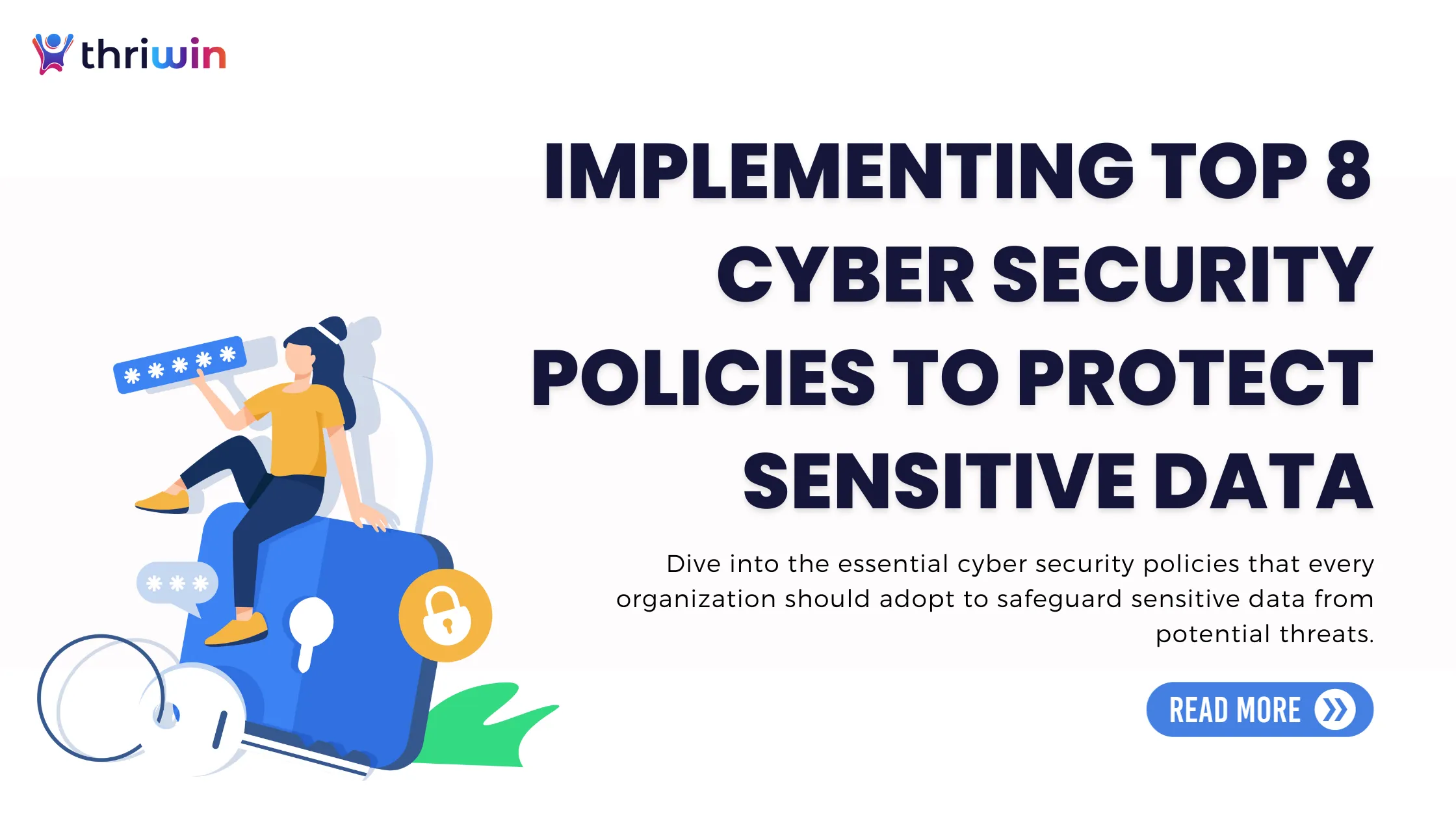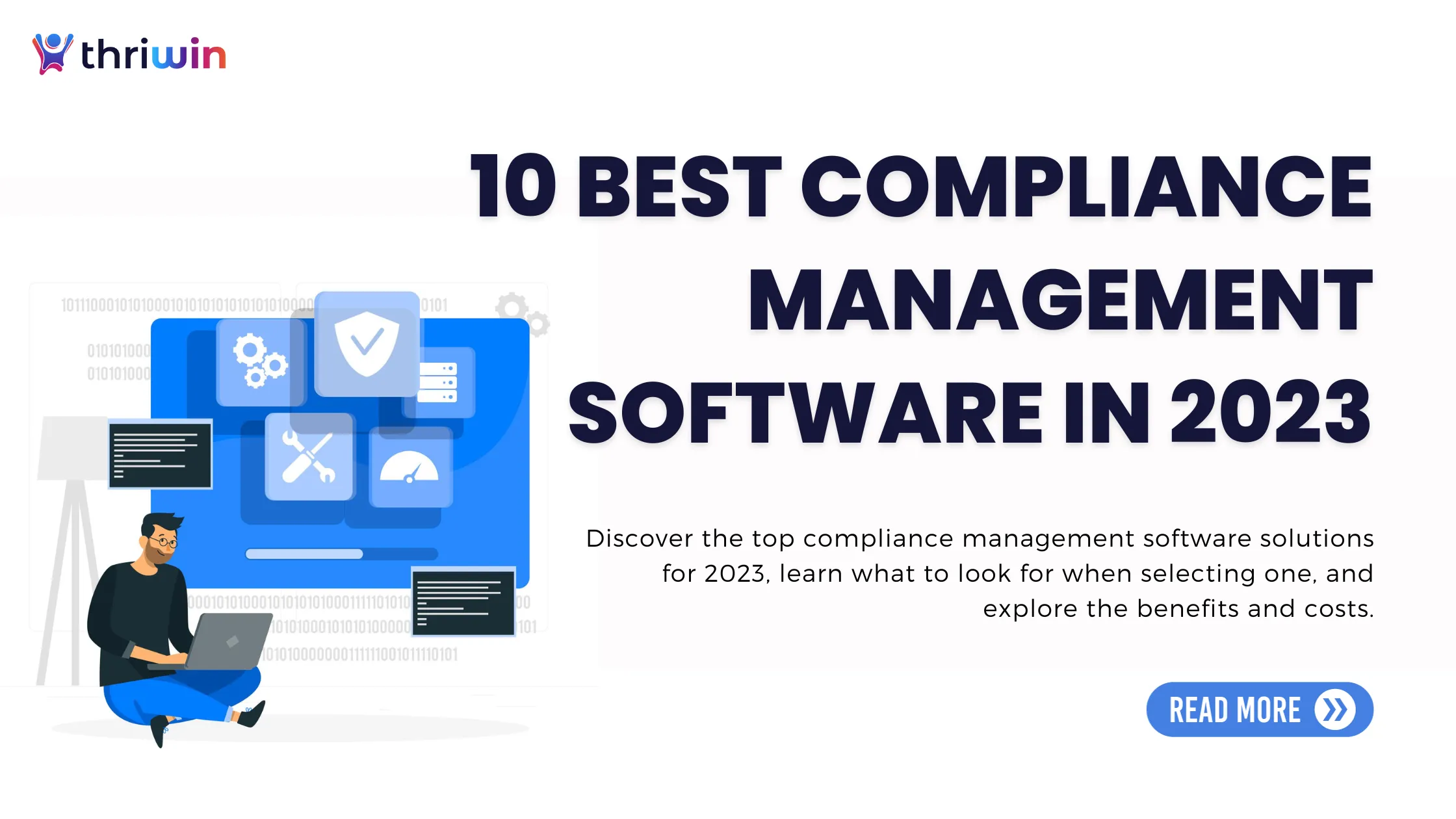With all the relentless technological advancement, the protection of sensitive data has surged to the forefront of organizational priorities. As data breaches and cyber threats continue to evolve at breakneck speed, the importance of robust cyber security policies cannot be overstated.
This comprehensive guide will explore why every organization needs a cyber security policy and how it can mitigate the rising costs of cyberattacks and data breaches.
Why Organizations Need Cyber Security Policy
In today's interconnected landscape, online safety isn't just an option—it's a necessity. Every company, whether towering industry giants or fresh startups, needs to prioritize their digital defenses. The reason? The internet isn't static; threats evolve, and we must be prepared.
Harnessing Compliance Management Systems for Cybersecurity
When it comes to drafting, maintaining, and updating those crucial cybersecurity policies, compliance management systems, like Thriwin, can be invaluable. They offer a central hub where businesses can oversee their policies, ensuring they're not only up-to-date but also in line with the latest industry standards and regulatory mandates. This streamlined approach ensures a company's defense mechanisms are both robust and compliant.
In an era where digital vulnerabilities lurk at every corner, it's essential for organizations to adopt a proactive stance. Explore the compelling reasons why every organization, regardless of size or industry, must establish a robust cyber security policy to defend against the ever-evolving digital dangers.
The Rising Costs of Cyberattacks and Data Breaches
While the online world has given us incredible ease and connections, it's also opened the door to more cyberattacks and data breaches. Cyberattacks and data breaches have a significant financial impact on organizations. Beyond the immediate costs of remediation, organizations often face substantial legal and regulatory fines. Moreover, damaging a company's reputation can lead to losing trust among customers and partners. All these factors underscore the importance of having a robust cybersecurity policy in place.
Employees: The Potential Weak Links in Security
In addition to technology, human factors are equally critical. Employees can either bolster or compromise an organization's security posture. They are often the first line of defense against cyber threats, but they can also be unwitting accomplices to breaches. To ensure that employees understand security risks and their role in preventing them, employee training and awareness programs are essential elements of a cyber security policy. Additionally, policies regarding acceptable use of company devices and networks and guidelines for identifying and reporting suspicious activity are crucial for mitigating internal threats.
Legal Implications and Compliance Requirements
In the current regulatory environment, organizations are bound by a complex web of laws and standards governing data protection and cybersecurity. Legal and regulatory compliance is not optional; it's a mandatory aspect of conducting business. Non-compliance can result in hefty fines, legal actions, and damage to an organization's reputation. A comprehensive cyber security policy should address relevant laws and regulations, outlining how the organization intends to adhere to them. It should also detail processes for reporting and managing data breaches, as many data protection laws require
Key Components of an Effective Cyber Security Policy
A cyber security policy is only as good as its components. In this section, we will break down the key elements that should be included in your policy to ensure comprehensive protection.
Defining Roles and Responsibilities
A well-defined cyber security policy begins with assigning clear roles and responsibilities. Within any organization, it becomes paramount to establish a clear hierarchy of who holds accountability for various cybersecurity aspects. This includes not only IT professionals but also individuals across various departments. For example, the HR department may have employee training and awareness responsibilities, while the legal team may be responsible for compliance with data protection laws. Clearly outlining these roles and responsibilities in your policy ensures everyone knows their part in safeguarding sensitive data.
Addressing Specific Areas of Cybersecurity
Cybersecurity encompasses diverse aspects, from network security to data protection, demanding comprehensive strategies for each:
Network Security: Fortify networks with firewalls, IDS, encryption, and remote access guidelines.
Data Protection: Safeguard data through classification, encryption, access controls, and retention policies.
Endpoint Security: Manage BYOD, employ antivirus, and apply timely OS and app patches.
Incident Response: Prepare for incidents with detection, reporting, containment, and communication protocols.
Prioritizing Areas of Primary Importance
By prioritizing, organizations can ensure that their cybersecurity efforts are focused on the most important areas. While every aspect of security is necessary, some vulnerabilities pose a higher risk than others. For example, protecting customer data might precede securing less sensitive information. Prioritization ensures that limited resources are allocated where they will have the most significant impact on reducing risk.
Who should write the cybersecurity policies?
Importance of a Multi-Disciplinary Approach
While the IT department, primarily led by the CIO or CISO, is the mainstay for drafting information security policies, it's a collective endeavor involving various stakeholders. Their combined expertise ensures a comprehensive and actionable policy. Here's a breakdown:
- IT Security Professionals: Under the leadership of the CIO or CISO, they provide the technical foundation for the policy, addressing the latest cyber threats and solutions.
- C-Level Business Executives: This includes roles like the CEO, CFO, and COO. They define the organization's core security needs and allocate necessary resources. A policy that needs their buy-in risks being infeasible due to resource constraints.
- Legal Team: Tasked with ensuring the policy stays within legal boundaries, they ensure compliance with existing laws and regulatory frameworks.
- Human Resources (HR): They ensure every employee understands and complies with the cybersecurity measures. They're also the ones who handle policy violations and ensure workforce alignment with cybersecurity objectives.
- Senior Management: Apart from the C-suite, other high-ranking executives ensure cybersecurity aligns with the company's broader strategy, providing necessary resources for its successful deployment.
- External Cybersecurity Consultants: Bringing an outsider's perspective, they can spot vulnerabilities, conduct tests, and offer specialized insights.
- Procurement Departments: They vet external services and products to ensure third-party collaborations align with the organization's cybersecurity standards.
When sculpting the policy, it's key to include those whose roles are pivotal to its creation and long-term enforcement and success.
How to Create a Cyber Security Policy
Creating a cyber security policy is a complex but necessary endeavor. This section will guide you through creating a comprehensive and effective policy.
Establishing a Robust Cybersecurity Framework
A strong foundation is key to a successful policy. A cybersecurity framework provides a structured approach to building your policy. It outlines the key components and guidelines necessary for effective cybersecurity. Common frameworks include the NIST Cybersecurity Framework, ISO 27001, and CIS Controls. Choosing the right framework for your organization is the first step in policy creation.
Securing Perimeter and IoT Connections
With the proliferation of IoT devices, securing connections is more critical than ever.
Securing the organization's perimeter involves firewalls, intrusion detection systems, and secure access controls. IoT devices introduce additional complexity, and policies should address their unique security challenges, including firmware updates, authentication, and data encryption.
Adopting a People-Centric Security Approach
Your employees can be your greatest defense or vulnerability. Educating employees about cybersecurity best practices is essential. Policies should include training programs, awareness campaigns, and guidelines for reporting security incidents. A security-aware workforce is more likely to identify and mitigate threats.
Controlling Access to Sensitive Data
Access control is vital in preventing unauthorized access to sensitive information.
Well-defined access control policies define who has access to what data and under what circumstances. This includes user authentication, role-based access control, and the principle of least privilege, minimizing the risk of data breaches.
Effective Password Management
Weak passwords are a significant vulnerability. Password management policies should encourage strong, complex passwords and regular password changes. Additionally, policies should outline the use of multi-factor authentication (MFA) for added security.
Monitoring Activities of Privileged and Third-Party Users
Monitoring policies should specify what activities are monitored, how data is collected and stored, and who can track data. Privileged users, such as administrators, should undergo stricter monitoring due to their elevated access levels. Third-party users should be subject to contractual agreements that require compliance with your security policies.
Managing Supply Chain Risks
Supply chain vulnerabilities can expose your organization to risks. It should address vendor assessments, contractual agreements, and ongoing monitoring of third-party security practices. The goal is to extend your organization's security standards to the entire supply chain.
The Role of Stakeholders in Policy Creation
Every stakeholder brings a unique lens, ensuring that cybersecurity policies are not only comprehensive but also relevant and actionable. Here are the roles various stakeholders play. In this section, we'll explore the involvement of various stakeholders in creating and enforcing cybersecurity policies.
Involvement of C-level Executives
C-level executives provide leadership and allocate resources for cybersecurity initiatives. Their active involvement is essential in setting a strong security culture and ensuring policies align with business goals.
Legal and Compliance Considerations
Legal and compliance teams ensure that your policies align with regulations. They are pivotal in providing expertise in interpreting and applying relevant laws and regulations to cybersecurity policies and ensuring that policies meet legal requirements and industry standards.
Human Resources and Employee Training
HR is responsible for creating and implementing cybersecurity training programs. They manage onboarding and offboarding procedures and ensure employees are aware of security policies on day one.
Procurement and Vendor Management
Procurement and vendor management policies should outline criteria for selecting vendors with strong security practices. Contracts with vendors should include clauses that require adherence to your cybersecurity policies and regular security assessments.
Regularly Updating and Auditing Cybersecurity Procedures
The Need for Annual Policy Review
As cyber threats continually evolve, it's crucial for policies to keep pace. Annual policy reviews involve thoroughly assessing how well existing policies are working, identifying areas that can be improved, and updating policies to tackle emerging threats effectively.
Conducting Policy Audits
Regular audits ensure policy adherence and effectiveness, evaluating whether policies are being followed, measuring their effectiveness, and identifying gaps or non-compliance. Audits should be conducted regularly to ensure ongoing policy adherence.
Addressing Evolving Threats and Technologies
To remain effective, policies must adapt to address new threats and technologies. This includes staying informed about emerging threats, adopting new security measures, and providing ongoing employee training.
Final Thoughts
In conclusion, implementing effective cyber security policies is no longer an option but necessary in today's digital landscape. The rising costs of cyberattacks and data breaches, along with legal obligations, make it imperative for organizations to prioritize cybersecurity. Regular updates and audits are key to ensuring your policies remain effective against evolving threats. Following this comprehensive guide can effectively strengthen your organization's cybersecurity posture and safeguard sensitive data.
Take action today and bolster your organization's compliance with Thriwin, your trusted partner in compliance management.
Remember, maintaining adherence to industry standards and regulations is crucial. Don't wait for a compliance mishap. With Thriwin's expertise, ensure you're always a step ahead in managing what's most vital for your business.
Take action today and fortify your organization's defenses against cyber threats with Thriwin, your trusted ally in cybersecurity.
Remember, the safety of your sensitive data is in your hands. Don't wait until it's too late. Act now to protect what matters most.
%201.svg)




.avif)


